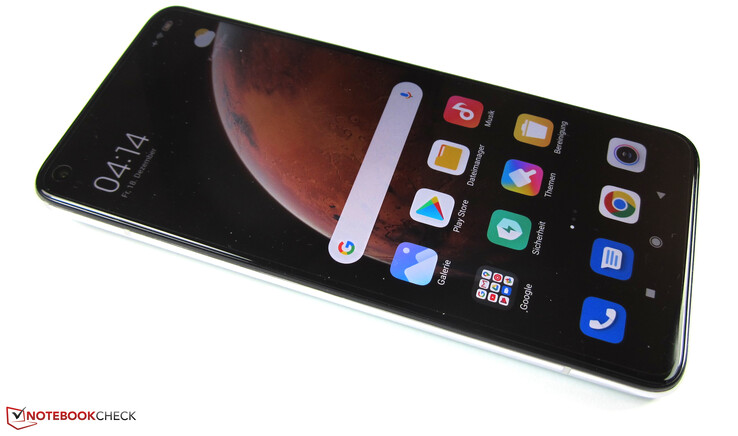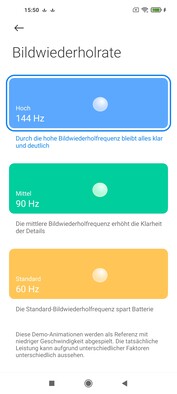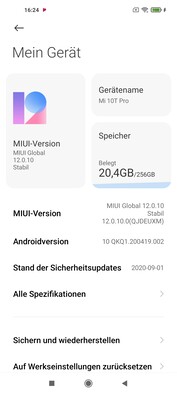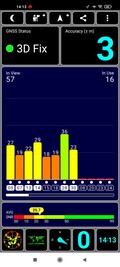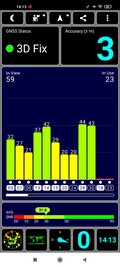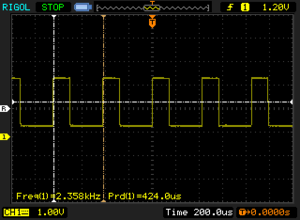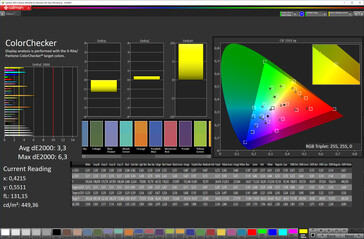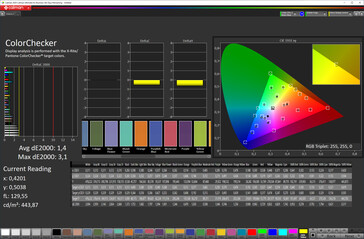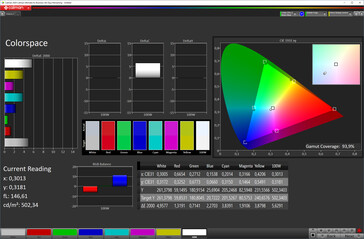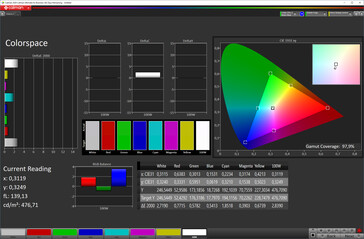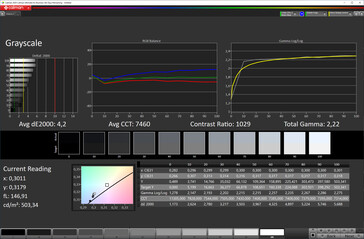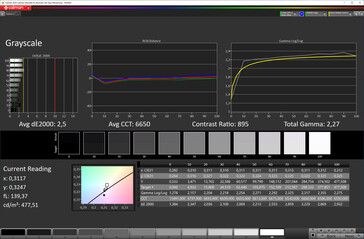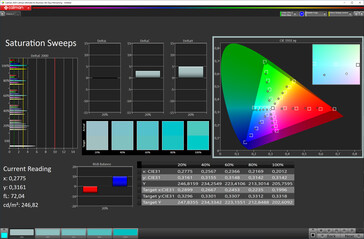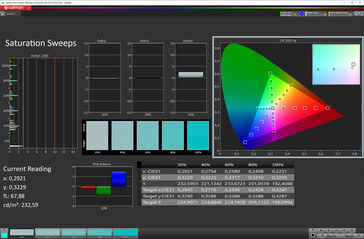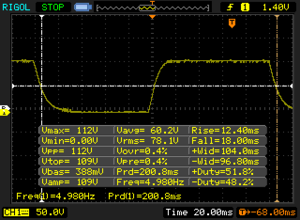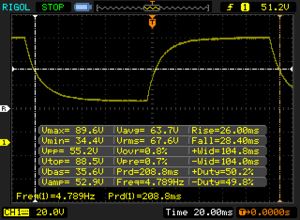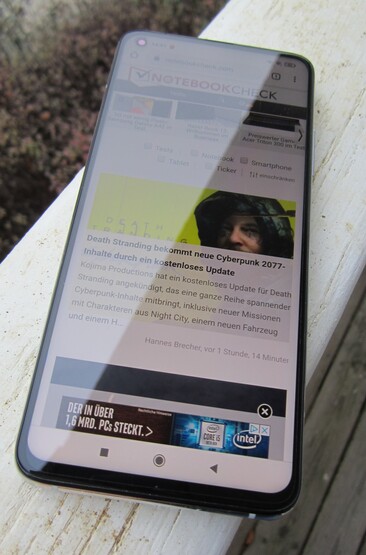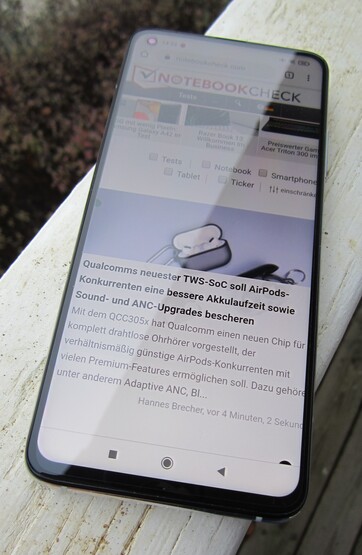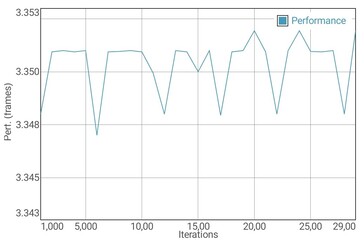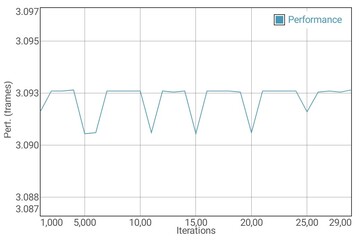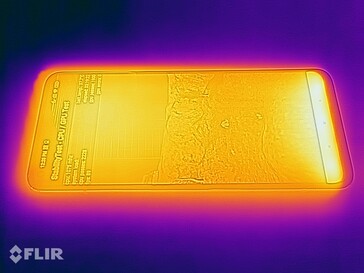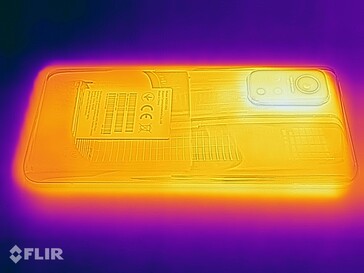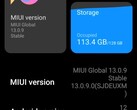Xiaomi Mi 10T Pro 5G review: Has almost everything that defines a top smartphone
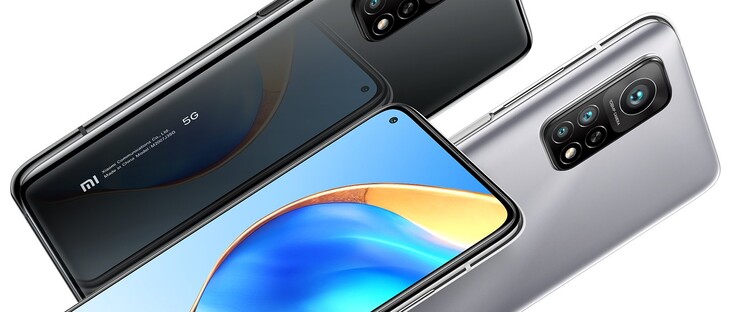
Xiaomi's Mi series is at the top of the manufacturer's smartphone hierarchy with the Mi 10 Pro being the current flagship. The Mi 10T smartphones follow right behind, led by our Mi 10T Pro review candidate, the successor to the Mi 9T Pro.
What differentiates the Mi 10T Pro from the Mi 10 Pro? The additional "T" in the product name actually sounds like there are more features. However, it actually means that the Mi 10T Pro makes some compromises here and there. An example is the display, because there's only an IPS panel instead of an AMOLED one. As a result, the Mi 10T Pro is not a high-end smartphone like the Mi 10 Pro in terms of features, but it still competes in the upper class. It delivers top performance with the Snapdragon 865 and adds other goodies like a 144 Hz refresh rate and a 5,000 mAh battery to the equipment list.
Possible competitors compared
Rating | Date | Model | Weight | Drive | Size | Resolution | Price |
|---|---|---|---|---|---|---|---|
| 86.9 % v7 (old) | 12 / 2020 | Xiaomi Mi 10T Pro 5G SD 865, Adreno 650 | 218 g | 256 GB UFS 3.1 Flash | 6.67" | 2400x1080 | |
| 89.4 % v7 (old) | 04 / 2020 | Huawei P40 Pro Kirin 990 5G, Mali-G76 MP16 | 209 g | 256 GB UFS 3.0 Flash | 6.58" | 2640x1200 | |
| 88.5 % v7 (old) | 04 / 2020 | OnePlus 8 Pro SD 865, Adreno 650 | 199 g | 256 GB UFS 3.0 Flash | 6.78" | 3168x1440 | |
| 86.1 % v7 (old) | 06 / 2020 | Realme X50 Pro SD 865, Adreno 650 | 205 g | 256 GB UFS 3.0 Flash | 6.44" | 2400x1080 | |
| 87.9 % v7 (old) | 02 / 2021 | Samsung Galaxy S20 FE 5G SD 865, Adreno 650 | 190 g | 128 GB UFS 3.1 Flash | 6.50" | 2400x1080 | |
| 86.3 % v7 (old) | 12 / 2020 | Xiaomi Mi 10T 5G SD 865, Adreno 650 | 216 g | 128 GB UFS 3.1 Flash | 6.67" | 2400x1080 |
Case - Classy mixture of Gorilla Glass 5 and aluminum
The 6.67-inch Mi 10T Pro weighs 218 grams, which is slightly more than many other smartphones in this form factor. However, this is due to the material mix of glass and metal, which also makes it feel quite premium. The screen and back are protected by Gorilla Glass 5 and enclosed by an aluminum frame. Together, this results in a robust chassis.
Unlike the Mi 10 Pro, the display of the Mi 10T Pro is not curved on the side edges and might not look quite as elegant, but the version that is preferred is ultimately a matter of taste. In contrast to the Mi 10 Pro, the fingerprint scanner isn't located underneath the screen but is integrated into the power button. This is due to the display technology, because the Mi 10T Pro only has an IPS screen instead of an AMOLED panel like the Mi 10 Pro.
Xiaomi offers the Mi 10T Pro in three colors: "Aurora Blue" is featured in our review sample and is the most striking, because the glossy surface finish is complemented by a subtle pastel color gradient going from turquoise to violet. Like with the Mi 10T, the other colors are "Cosmic Black" and "Lunar Silver". The Xiaomi phone doesn't have an IP certification.
Connectivity - 8 GB of RAM and up to 256 GB of storage in the Xiaomi Mi 10T Pro
The Xiaomi Mi 10T Pro has 8 GB of LPDDR5 RAM and either 128 or 256 GB of UFS 3.1 storage. The storage configuration is the only big difference compared to the Mi 10T besides the camera. The latter only offers 6 GB of RAM and a maximum of 128 GB of internal storage. The storage can't be expanded due to the lack of a microSD slot.
The included adapter (USB-C to 3.5 mm jack) is needed for connecting wired headsets or speakers to the Xiaomi phone. The physical ports are, therefore, limited to the USB-C port, which works at USB 2.0 speeds, and the dual-SIM slot right next to it.
Like the Mi 10T, the Mi 10T Pro also features a notification LED above the display as well as an IR blaster on the top side. Thanks to the support of DRM Widevine L1, the Xiaomi smartphone can also stream content in HD quality.
Software - Android 10, MIUI 12, almost no bloatware
The Mi 10T Pro runs Android 10 and Xiaomi's MIUI user interface in the latest version 12. On the other hand, the Android security updates weren't quite up to date and were still at the level of September 1 at the time of testing. However, Xiaomi usually updates its current smartphones every four months, so we can expect that new security updates will be available in January.
Our review sample is the large version with 256 GB of storage, of which just under 236 GB is available. Some space can still be freed up by deleting the few preinstalled third-party apps like Facebook or WPS Office.
Communication and GPS - 5G and fast Wi-Fi 6
All smartphones from Xiaomi's current Mi product family support 5G. The Mi 10T Pro provides support for the 1/3/7/8/20/28/38/41/77 and 78 bands. Those who don't need a super-fast mobile network yet or who, like us, live in a place where there's no 5G are equally well served with Xiaomi's 4G. The 4G network reception is good, and there shouldn't be any connection problems in other European countries thanks to the broad frequency coverage (bands 1/2/3/4/5/7/8/20/28/32/38/40/41).
Bluetooth 5.1, NFC, and Wi-Fi 6 including 4x4 MIMO are available for short-range wireless connections. The measurements with our Netgear Nighthawk AX12 reference router show that the Mi 10T Pro is fast when using Wi-Fi. It sends data at an average of 631 Mb/s and receives it at 852 Mb/s on average. The transmission power is probably significantly lower because Xiaomi only uses MIMO for reception.
| Networking | |
| iperf3 transmit AX12 | |
| Huawei P40 Pro | |
| OnePlus 8 Pro | |
| Realme X50 Pro | |
| Samsung Galaxy S20 FE 5G | |
| Xiaomi Mi 10T Pro 5G | |
| Xiaomi Mi 10T 5G | |
| iperf3 receive AX12 | |
| Realme X50 Pro | |
| Xiaomi Mi 10T Pro 5G | |
| OnePlus 8 Pro | |
| Huawei P40 Pro | |
| Samsung Galaxy S20 FE 5G | |
| Xiaomi Mi 10T 5G | |
The Mi 10T Pro uses GPS, Glonass, Galileo, and BeiDou to determine its current location. In the test, the smartphone manages this with an accuracy of three meters both indoors and outdoors, and the positioning only takes a few seconds in each case.
This isn't that different when you are on the move, because the GPS is also precise enough for everyday use. On an approximately 12-kilometer bike tour, the Mi 10T Pro delivers position data that is almost as accurate as with the Garmin Edge 500 professional navigation device. The fact that the smartphone's tracking is a bit off the ideal line from time to time shouldn't play a decisive role in practice.
Telephone and call quality
The Mi 10T Pro supports Wi-Fi calls and VoLTE, provided that both are also available with the respective network carrier. If you use two SIM cards, you can only connect to 5G networks with one of them. On the other hand, 4G connections are also possible with two SIM cards at the same time.
We like the call quality of the Mi 10T Pro. All the participants in the call could hear each other clearly and distinctly during the test calls. Background noise is still filtered out quite reliably even when the speakerphone function is being used, and voices are transmitted well.
Cameras - 108 MP photos but no optical zoom
108 MP instead of 64 MP: Xiaomi's Mi 10T Pro features a camera with twice the resolution of the Mi 10T. The sensor is also different. Instead of the Sony IMX682 of its sibling model, the Samsung HMX is used, just like in the Mi 10 Pro. The 1/1.33" sensor works with an aperture of f/1.7 and also has an optical image stabilizer in addition to autofocus.
In auto mode, the main camera combines four pixels into one. If you switch to the 108 MP mode in the camera settings, you can also use the full photo resolution (12,032x9,024 pixels). The Samsung HMX can record videos in 8K at 30 frames per second and in 4K at 60 frames per second even.
The main camera takes very good pictures in bright ambient light that convince with high color accuracy and strong contrast. The image sharpness could still be a bit higher at the edges, but that's just nitpicking. Various shooting modes encourage you to experiment, including a long-exposure and a clone function; the latter allows you to take several pictures of people and then place them in one same photo. This works similarly in video mode.
The 20 MP selfie camera also does its job well: It shoots crisp pictures that are characterized by a natural color reproduction. Besides various lighting and filter effects, it also manages good bokeh shots in portrait mode.
Users who take a lot of pictures in the dark or in low-light conditions are also well served with the Mi 10T Pro. Although its photography skills don't quite reach the smartphone upper league because the low-light photos are a bit too noisy and blurry, the difference is huge compared with the Mi 10T with its Sony sensor. The Mi 10T Pro takes much better pictures at night.
The main camera is accompanied by a 13 MP ultra wide-angle camera (f/2.4, FOV up to 123°) and a 5 MP macro camera with autofocus (f/2.4, FOV 82°). Unfortunately, the Mi 10T Pro does without an optical zoom, which is a real step backwards compared with the Mi 10 Pro and its 12 MP telephoto lens. However, the high pixel capacity of the main camera still makes pictures look quite decent, as long as you don't take them using too much digital zoom.
The two additional lenses are rather nice extras than actually useful tools. Photos taken with the ultra wide-angle camera always look a bit too colorful and are very blurry at the edges. When it comes to using the macro camera, better and usually sharper photos can often be achieved by holding the smartphone a bit further away from the intended subject and then zooming in.
Image comparison
Choose a scene and navigate within the first image. One click changes the position on touchscreens. One click on the zoomed-in image opens the original in a new window. The first image shows the scaled photograph of the test device.
Daylight-Scene 1Daylight-Scene 25x zoomUltra-wide angleLow light-SurroundingsUnder controlled lighting conditions, we can see that the Mi 10T Pro reproduces colors naturally. The test chart is no longer too sharp under artificial low light, but the individual elements can still be recognized well.


Accessories and warranty - 33-watt power adapter and protective case in the box
In the box, the Xiaomi Mi 10T Pro comes with a 33-watt power adapter, a USB-C cable (Type-A to Type-C), a SIM tool, a USB-C adapter (USB-C to 3.5 mm audio jack), a transparent protective case, a quick-start guide, and warranty information.
The Mi 10T Pro is backed by a 24-month warranty.
Input devices and handling - Butter-smooth controls thanks to the 144-Hz panel
The blazing-fast Snapdragon 865 and the adjustable refresh rate of up to 144 Hz ensure that the Mi 10T Pro can be used very smoothly. It's almost impossible to find other devices where you can scroll through menus and websites more smoothly, since most competitors stop at 120 Hz. User authentication via the fingerprint scanner also works without issues, and it recognizes us almost instantly. Provided that the ambient light is suitable, logging in via facial recognition is also quick.
Display - Bright and high-contrast IPS display
The IPS display of the MI 10T Pro has a resolution of 2400x1080 pixels earns plus points in the test with its vivid color reproduction and homogeneous brightness distribution. It has an average brightness of 602 cd/m² with a pure white background. If you repeat the measurement with evenly distributed bright and dark areas (APL50), you can achieve up to 618 cd/m². When the brightness sensor is deactivated, the maximum luminance drops to 508 cd/m².
PWM flickering does occur but only at a display brightness of 60% and below. Furthermore, the PWM frequency of 2,358 Hz is so high that even sensitive users shouldn't feel bothered by it.
| |||||||||||||||||||||||||
Brightness Distribution: 90 %
Center on Battery: 601 cd/m²
Contrast: 1252:1 (Black: 0.48 cd/m²)
ΔE ColorChecker Calman: 1.4 | ∀{0.5-29.43 Ø4.78}
ΔE Greyscale Calman: 2.5 | ∀{0.09-98 Ø5}
97.9% sRGB (Calman 2D)
Gamma: 2.27
CCT: 6650 K
| Xiaomi Mi 10T Pro 5G IPS, 2400x1080, 6.7" | Xiaomi Mi 10T 5G IPS, 2400x1080, 6.7" | Huawei P40 Pro OLED, 2640x1200, 6.6" | OnePlus 8 Pro AMOLED, 3168x1440, 6.8" | Realme X50 Pro OLED, 2400x1080, 6.4" | Samsung Galaxy S20 FE 5G Super AMOLED, 2400x1080, 6.5" | |
|---|---|---|---|---|---|---|
| Screen | 12% | 12% | 37% | -43% | -5% | |
| Brightness middle (cd/m²) | 601 | 614 2% | 584 -3% | 796 32% | 679 13% | 714 19% |
| Brightness (cd/m²) | 602 | 593 -1% | 576 -4% | 779 29% | 690 15% | 721 20% |
| Brightness Distribution (%) | 90 | 92 2% | 95 6% | 94 4% | 97 8% | 95 6% |
| Black Level * (cd/m²) | 0.48 | 0.48 -0% | ||||
| Contrast (:1) | 1252 | 1279 2% | ||||
| Colorchecker dE 2000 * | 1.4 | 0.9 36% | 1.1 21% | 0.68 51% | 3.2 -129% | 1.8 -29% |
| Colorchecker dE 2000 max. * | 3.1 | 2.5 19% | 2.3 26% | 1.55 50% | 6.2 -100% | 5.1 -65% |
| Greyscale dE 2000 * | 2.5 | 1.6 36% | 1.8 28% | 1.1 56% | 4.1 -64% | 2 20% |
| Gamma | 2.27 97% | 2.2 100% | 2.16 102% | 2.237 98% | 2.28 96% | 2.16 102% |
| CCT | 6650 98% | 6744 96% | 6355 102% | 6310 103% | 6604 98% | 6588 99% |
* ... smaller is better
Screen Flickering / PWM (Pulse-Width Modulation)
| Screen flickering / PWM detected | 2358 Hz | ≤ 60 % brightness setting | |
The display backlight flickers at 2358 Hz (worst case, e.g., utilizing PWM) Flickering detected at a brightness setting of 60 % and below. There should be no flickering or PWM above this brightness setting. The frequency of 2358 Hz is quite high, so most users sensitive to PWM should not notice any flickering. In comparison: 53 % of all tested devices do not use PWM to dim the display. If PWM was detected, an average of 8101 (minimum: 5 - maximum: 343500) Hz was measured. | |||
In the lab measurements, the Mi 10T Pro achieves a contrast of 1,252:1, which is strong by IPS standards, and a color accuracy that is within the ideal range with Delta E deviations that are below 3. To obtain this exact color reproduction, you have to switch from the preset "Auto" display mode to the "Original Color" mode.
Display Response Times
| ↔ Response Time Black to White | ||
|---|---|---|
| 30.4 ms ... rise ↗ and fall ↘ combined | ↗ 12.4 ms rise | |
| ↘ 18 ms fall | ||
| The screen shows slow response rates in our tests and will be unsatisfactory for gamers. In comparison, all tested devices range from 0.1 (minimum) to 240 (maximum) ms. » 82 % of all devices are better. This means that the measured response time is worse than the average of all tested devices (20.2 ms). | ||
| ↔ Response Time 50% Grey to 80% Grey | ||
| 54.4 ms ... rise ↗ and fall ↘ combined | ↗ 26 ms rise | |
| ↘ 28.4 ms fall | ||
| The screen shows slow response rates in our tests and will be unsatisfactory for gamers. In comparison, all tested devices range from 0.165 (minimum) to 636 (maximum) ms. » 91 % of all devices are better. This means that the measured response time is worse than the average of all tested devices (31.6 ms). | ||
Performance - Snapdragon 865 guarantees top performance
The high-end Snapdragon 865 SoC provides the Mi 10T Pro with a lot of computing power; in combination with the 8 GB of LPDDR5 RAM and the fast UFS 3.1 storage, the SoC offers a first-class system performance: Nothing lags, apps load in no time, and the smartphone generally gives the impression of not being overtaxed by anything. This impression is also present when browsing the web: Loading times are minimal, and websites are displayed very quickly.
Two interesting details: In GFXBench, the Xiaomi phone limits the on-screen rates to 50 FPS, probably due to thermal reasons. And with the Vulkan API, the 3DMark scores are pretty lousy, which is a sign for poor drivers.
| AnTuTu v8 - Total Score (sort by value) | |
| Xiaomi Mi 10T Pro 5G | |
| Xiaomi Mi 10T 5G | |
| Huawei P40 Pro | |
| OnePlus 8 Pro | |
| Realme X50 Pro | |
| Samsung Galaxy S20 FE 5G | |
| Average Qualcomm Snapdragon 865 (527301 - 631025, n=24) | |
| AImark - Score v2.x (sort by value) | |
| Xiaomi Mi 10T Pro 5G | |
| Xiaomi Mi 10T 5G | |
| Huawei P40 Pro | |
| Average Qualcomm Snapdragon 865 (107923 - 119152, n=3) | |
| Jetstream 2 - 2.0 Total Score | |
| Average of class Smartphone (23.8 - 387, n=149, last 2 years) | |
| Xiaomi Mi 10T Pro 5G (Chrome 87.0.4280.101) | |
| Xiaomi Mi 10T 5G (Chrome 87.0.4280.66) | |
| Huawei P40 Pro (Huawei Browser 10.1) | |
| Realme X50 Pro (Chrome 83) | |
| Average Qualcomm Snapdragon 865 (45.2 - 77, n=20) | |
| OnePlus 8 Pro (Chrome 80) | |
| Samsung Galaxy S20 FE 5G (Chrome 81.0.4044.138) | |
| JetStream 1.1 - Total Score | |
| Xiaomi Mi 10T Pro 5G (Chrome 87.0.4280.101) | |
| Xiaomi Mi 10T 5G (Chrome 87.0.4280.66) | |
| Realme X50 Pro (Chrome 83) | |
| Huawei P40 Pro (Huawei Browser 10.1) | |
| OnePlus 8 Pro (Chrome 80) | |
| Average Qualcomm Snapdragon 865 (74.2 - 145.1, n=21) | |
| Samsung Galaxy S20 FE 5G (Chrome 81.0.4044.138) | |
| Speedometer 2.0 - Result 2.0 | |
| Average of class Smartphone (15.2 - 643, n=122, last 2 years) | |
| Huawei P40 Pro (Huawei Browser 10.1) | |
| Xiaomi Mi 10T Pro 5G (Chrome 87.0.4280.101) | |
| OnePlus 8 Pro (Chome 80) | |
| Xiaomi Mi 10T 5G (Chrome 87.0.4280.66) | |
| Realme X50 Pro (Chrome 83) | |
| Average Qualcomm Snapdragon 865 (30.6 - 74.5, n=19) | |
| Samsung Galaxy S20 FE 5G (Chrome 81.0.4044.138) | |
| WebXPRT 3 - Overall | |
| Average of class Smartphone (38 - 380, n=31, last 2 years) | |
| Samsung Galaxy S20 FE 5G (Chrome 81.0.4044.138) | |
| Average Qualcomm Snapdragon 865 (97 - 127, n=23) | |
| OnePlus 8 Pro (Chrome 80) | |
| Xiaomi Mi 10T 5G (Chrome 87.0.4280.66) | |
| Realme X50 Pro (Chrome 83) | |
| Xiaomi Mi 10T Pro 5G (Chrome 87.0.4280.101) | |
| Huawei P40 Pro | |
| Octane V2 - Total Score | |
| Average of class Smartphone (2228 - 121337, n=197, last 2 years) | |
| Xiaomi Mi 10T 5G (Chrome 87.0.4280.66) | |
| Realme X50 Pro | |
| Xiaomi Mi 10T Pro 5G (Chrome 87.0.4280.101) | |
| Huawei P40 Pro (Huawei Browser 10.1) | |
| OnePlus 8 Pro (Chrome 80) | |
| Average Qualcomm Snapdragon 865 (14606 - 31224, n=23) | |
| Samsung Galaxy S20 FE 5G (Chrome 81.0.4044.138) | |
| Mozilla Kraken 1.1 - Total | |
| Samsung Galaxy S20 FE 5G (Chrome 81.0.4044.138) | |
| Xiaomi Mi 10T 5G (Chrome 87.0.4280.66) | |
| Average Qualcomm Snapdragon 865 (1623 - 2911, n=24) | |
| Realme X50 Pro (Chrome 83) | |
| Realme X50 Pro | |
| OnePlus 8 Pro (Chrome 80) | |
| Huawei P40 Pro (Huawei Browser 10.1) | |
| Xiaomi Mi 10T Pro 5G (Chrome 87.0.4280.101) | |
| Average of class Smartphone (257 - 28190, n=154, last 2 years) | |
* ... smaller is better
| Xiaomi Mi 10T Pro 5G | Xiaomi Mi 10T 5G | Huawei P40 Pro | OnePlus 8 Pro | Realme X50 Pro | Samsung Galaxy S20 FE 5G | Average 256 GB UFS 3.1 Flash | Average of class Smartphone | |
|---|---|---|---|---|---|---|---|---|
| AndroBench 3-5 | 8% | 4% | 4% | 15% | 4% | 46% | 82% | |
| Sequential Read 256KB (MB/s) | 1348 | 1635 21% | 1775 32% | 1627 21% | 1756 30% | 1528 13% | 1757 ? 30% | 2228 ? 65% |
| Sequential Write 256KB (MB/s) | 671 | 722 8% | 395.7 -41% | 730 9% | 756 13% | 676 1% | 1204 ? 79% | 1852 ? 176% |
| Random Read 4KB (MB/s) | 213.8 | 231 8% | 228.1 7% | 208.3 -3% | 229.4 7% | 228.4 7% | 287 ? 34% | 296 ? 38% |
| Random Write 4KB (MB/s) | 228.3 | 211.2 -7% | 271.8 19% | 197.7 -13% | 252 10% | 218.4 -4% | 318 ? 39% | 339 ? 48% |
| Sequential Read 256KB SDCard (MB/s) | 82.3 ? | 85.8 ? | 75.9 ? | |||||
| Sequential Write 256KB SDCard (MB/s) | 68.1 ? | 68.6 ? | 61.9 ? |
Games - The Mi 10T Pro is a gaming machine
The Snapdragon 865 with its high-end Adreno 650 graphics chip and the 144 Hz display make the Mi 10T a gaming machine. You can actually always expect games to run smoothly even in high details; we also observed this with our game selection.
PUBG Mobile runs at a constant 30 FPS in the HD setting, and it would have been rendered even more smoothly if the game had allowed it - up to 60 FPS is possible here. The smartphone is also underchallenged in Armajet, as it can't display its maximum refresh rate of 144 Hz here, since a maximum of 120 FPS can be selected within the game. We determined the frame rates with our Gamebench test tool.
Emissions - Mi 10 Pro always remains cool under load
Temperature
Although the Mi 10T Pro is equipped with a very powerful SoC, it remains cool even under prolonged load. The smartphone heats up to a maximum of 38.5 °C (~101 °F) in the stress test and never feels uncomfortably warm to the touch as a result.
It can also dissipate its operating heat well internally, because the SoC performance is not throttled as GFXBench's battery tests show. However, throttling can't be ruled out, because the Xiaomi phone limits its FPS performance to 50 frames per second in both GFXBench tests, which means that the SoC isn't completely used to its full potential.
| 3DMark - Wild Life Stress Test Stability | |
| Xiaomi Mi 10T Pro 5G | |
(+) The maximum temperature on the upper side is 38.5 °C / 101 F, compared to the average of 35.2 °C / 95 F, ranging from 21.9 to 247 °C for the class Smartphone.
(+) The bottom heats up to a maximum of 35.3 °C / 96 F, compared to the average of 34 °C / 93 F
(+) In idle usage, the average temperature for the upper side is 27.3 °C / 81 F, compared to the device average of 32.9 °C / 91 F.
Speakers
The Mi 10T Pro has stereo speakers, one of which is located next to the USB-C port at the bottom and the second under a narrow opening on the display's top side. The two speakers produce a passable sound, but it's a bit thin due to the lack of bass tones.
You can connect wired headsets or headphones to the smartphone via the included USB-C adapter or pair them wirelessly with it via Bluetooth 5.1. Qualcomm True Wireless is supported when connecting with Bluetooth.
Xiaomi Mi 10T Pro 5G audio analysis
(+) | speakers can play relatively loud (90.8 dB)
Bass 100 - 315 Hz
(-) | nearly no bass - on average 26.4% lower than median
(±) | linearity of bass is average (7.1% delta to prev. frequency)
Mids 400 - 2000 Hz
(±) | higher mids - on average 5% higher than median
(+) | mids are linear (4.8% delta to prev. frequency)
Highs 2 - 16 kHz
(+) | balanced highs - only 4.5% away from median
(+) | highs are linear (2.7% delta to prev. frequency)
Overall 100 - 16.000 Hz
(±) | linearity of overall sound is average (18.5% difference to median)
Compared to same class
» 20% of all tested devices in this class were better, 9% similar, 71% worse
» The best had a delta of 11%, average was 35%, worst was 134%
Compared to all devices tested
» 41% of all tested devices were better, 8% similar, 52% worse
» The best had a delta of 4%, average was 24%, worst was 134%
Xiaomi Mi 10T 5G audio analysis
(+) | speakers can play relatively loud (91.3 dB)
Bass 100 - 315 Hz
(-) | nearly no bass - on average 25.2% lower than median
(±) | linearity of bass is average (8.2% delta to prev. frequency)
Mids 400 - 2000 Hz
(±) | higher mids - on average 5.2% higher than median
(+) | mids are linear (4.5% delta to prev. frequency)
Highs 2 - 16 kHz
(±) | higher highs - on average 5.5% higher than median
(+) | highs are linear (3.2% delta to prev. frequency)
Overall 100 - 16.000 Hz
(±) | linearity of overall sound is average (18.8% difference to median)
Compared to same class
» 22% of all tested devices in this class were better, 10% similar, 68% worse
» The best had a delta of 11%, average was 35%, worst was 134%
Compared to all devices tested
» 42% of all tested devices were better, 8% similar, 50% worse
» The best had a delta of 4%, average was 24%, worst was 134%
Battery life - Very enduring, completely charged after an hour
Energy consumption
The 33-watt power adapter recharges the Mi 10T Pro within a short time. It only takes about half an hour to bring the 5,000 mAh battery from 0 to 50% in the test. According to the manufacturer, it should reach 100% after one hour. In our test, the charging process takes a bit longer with 1:16 hours, but it's still very fast. The smartphone doesn't support wireless charging.
The Mi 10T Pro's power consumption shows no anomalies, but it consumes a bit more energy overall than comparison devices such as the Samsung Galaxy S20 FE.
| Off / Standby | |
| Idle | |
| Load |
|
Key:
min: | |
| Xiaomi Mi 10T Pro 5G 5000 mAh | Xiaomi Mi 10T 5G 5000 mAh | Huawei P40 Pro 4200 mAh | OnePlus 8 Pro 4510 mAh | Realme X50 Pro 4200 mAh | Samsung Galaxy S20 FE 5G 4500 mAh | Average Qualcomm Snapdragon 865 | Average of class Smartphone | |
|---|---|---|---|---|---|---|---|---|
| Power Consumption | 9% | 24% | -62% | 6% | 24% | -12% | 1% | |
| Idle Minimum * (Watt) | 0.7 | 0.52 26% | 0.92 -31% | 2.2 -214% | 1 -43% | 0.75 -7% | 1.133 ? -62% | 0.842 ? -20% |
| Idle Average * (Watt) | 2.27 | 2.11 7% | 1.41 38% | 3.3 -45% | 1.77 22% | 1.41 38% | 2.23 ? 2% | 1.439 ? 37% |
| Idle Maximum * (Watt) | 2.34 | 2.24 4% | 1.47 37% | 3.7 -58% | 1.86 21% | 1.44 38% | 2.45 ? -5% | 1.624 ? 31% |
| Load Average * (Watt) | 5.47 | 5.5 -1% | 3.35 39% | 5.9 -8% | 4.23 23% | 3.84 30% | 5.26 ? 4% | 7.03 ? -29% |
| Load Maximum * (Watt) | 9.78 | 9 8% | 6.37 35% | 8.3 15% | 9.13 7% | 7.67 22% | 9.68 ? 1% | 11.3 ? -16% |
* ... smaller is better
Battery life
The Mi 10T Pro's 5,000 mAh battery should easily last users for a whole day, even when the smartphone is used intensively. The Xiaomi phone lasts almost 20 hours in our simulated web-browsing test with a display brightness adjusted to 150 cd/m². During video playback, it even takes almost a whole day for the battery to run out.
| Xiaomi Mi 10T Pro 5G 5000 mAh | Xiaomi Mi 10T 5G 5000 mAh | Huawei P40 Pro 4200 mAh | OnePlus 8 Pro 4510 mAh | Realme X50 Pro 4200 mAh | Samsung Galaxy S20 FE 5G 4500 mAh | |
|---|---|---|---|---|---|---|
| Battery runtime | 0% | -36% | -21% | -37% | -24% | |
| Reader / Idle (h) | 51.3 | 51.8 1% | 24.6 -52% | 35.1 -32% | 25.1 -51% | 33.5 -35% |
| H.264 (h) | 23.5 | 24.1 3% | 19 -19% | 17.1 -27% | 17.2 -27% | 20.5 -13% |
| WiFi v1.3 (h) | 20 | 19.4 -3% | 12.4 -38% | 15.4 -23% | 12.9 -35% | 12.7 -36% |
| Load (h) | 4.9 | 4.9 0% | 3.3 -33% | 4.9 0% | 3.2 -35% | 4.3 -12% |
Pros
Cons
Verdict - Close to a high-end smartphone
The Mi 10T Pro delivers first-class performance in almost all areas. Highlights are the Snapdragon 865 SoC and the 144 Hz refresh rate, which provides a buttery-smooth usage. Other advantages: The very enduring 5,000 mAh battery and the quick charging times of just under an hour. The Mi 10T Pro inherits the sensor of its 108 MP camera from Xiaomi's Mi 10 Pro flagship and shoots very good photos with it.
The Xiaomi Mi 10T Pro comes close to Xiaomi's Mi 10 Pro flagship and is considerably cheaper, but it also makes some compromises in terms of features.
The fact that only an IPS panel is used instead of an AMOLED screen might scare off some buyers. However, the bright display of the Mi 10T Pro does a good job, since it shows crisp contrasts and precise colors.
Where else have corners been cut apart from the display? Unlike the Mi 10 Pro, the Mi 10T Pro doesn't have a telephoto lens and, therefore, no optical zoom. The smartphone also lacks an IP certification and wireless charging. We would've also liked the option to expand the storage via a microSD card, but even the Mi 10 series doesn't offer that.
A good alternative to the Mi 10T Pro is the Mi 10T. It's about 100 Euros cheaper (~$122), has a bit less storage (6 GB of RAM and a maximum of 128 GB of storage space), and uses a 64 MP camera, but that's about it in terms of differences. The Sony sensor in the Mi 10T takes significantly worse pictures than the Mi 10T Pro in low ambient light, but it's just as good in daylight.
Price and availability
In the 256 GB version that we tested, the Xiaomi Mi 10T Pro is available starting at around 680 Euros (~$830) from our lender notebooksbilliger.de, for example. The 128 GB version costs around 550 Euros (~$671).
Xiaomi Mi 10T Pro 5G
- 12/22/2020 v7 (old)
Manuel Masiero




